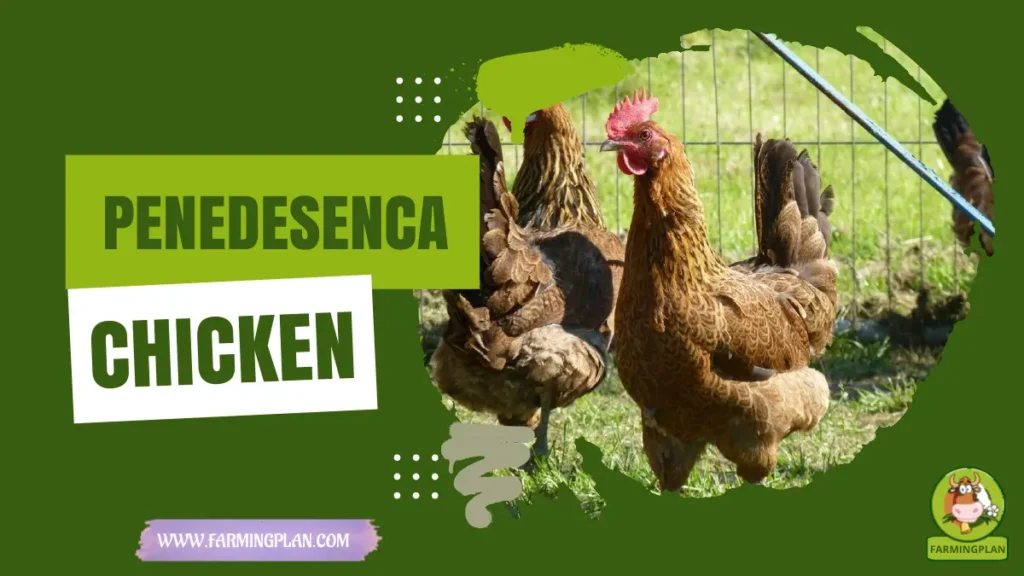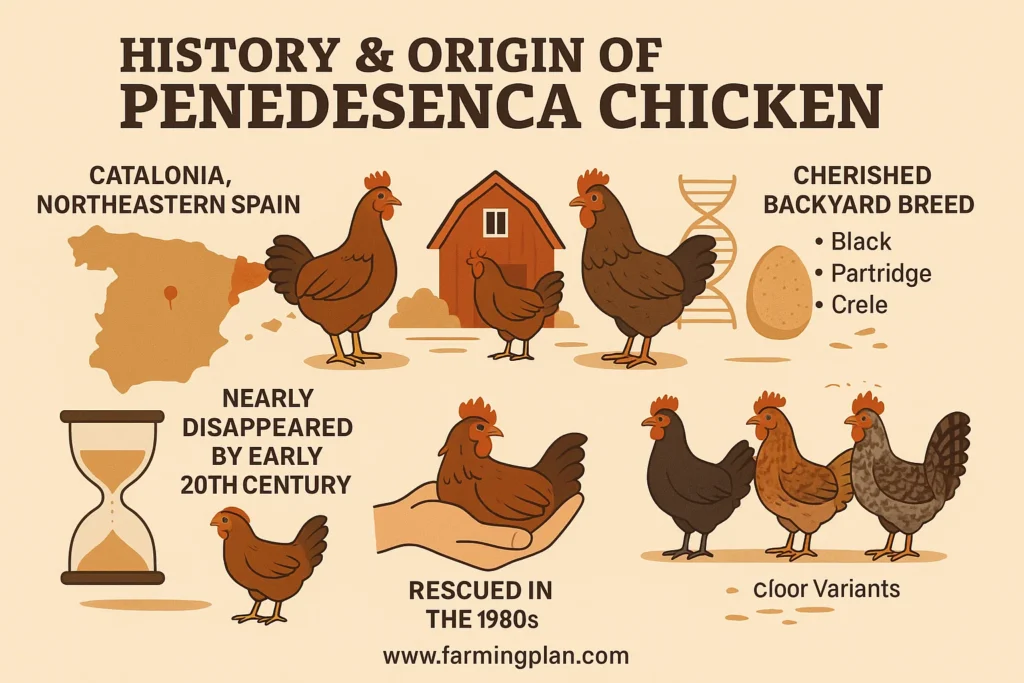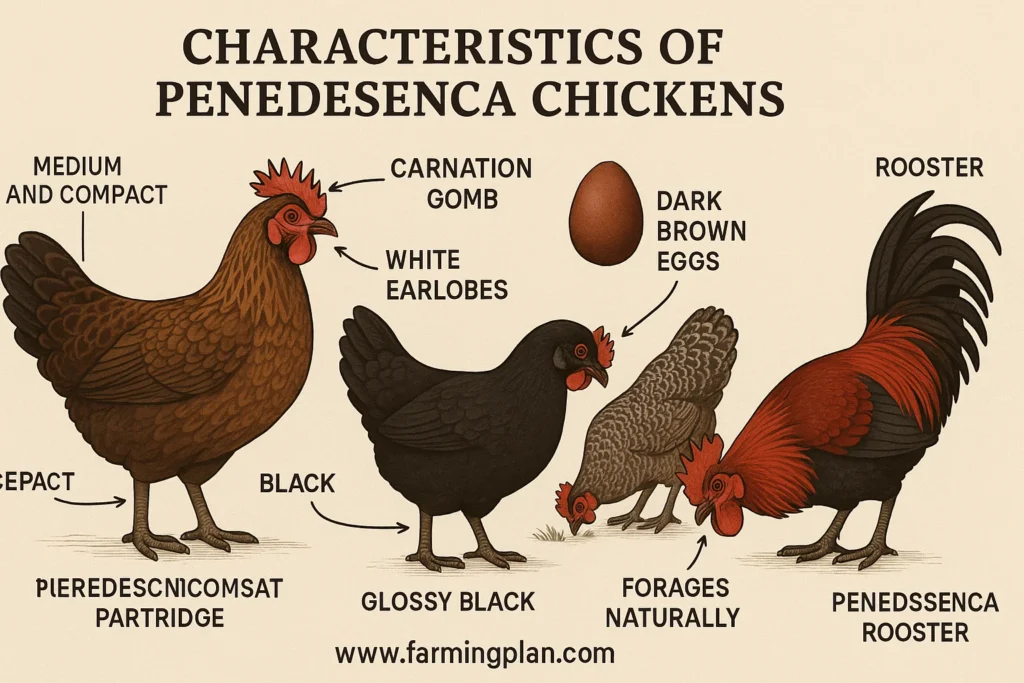If you’ve ever dreamed of adding a colorful, heat-tolerant bird to your backyard flock, the Penedesenca chicken might just be your new favorite. These rare Spanish beauties are known for their brilliant feather patterns, unique combs, and rich, dark brown eggs that look like they’ve been dipped in chocolate. As a farming specialist, I’ve worked with many chicken breeds, but the Penedesenca holds a special place in my coop. In this guide, I’ll walk you through their origin, traits, behavior, care, and why they’re a perfect fit for pet owners, farmers, and backyard chicken hobbyists who want something a little different—something a little more extraordinary.

History & Origin of Penedesenca Chicken
The Penedesenca chicken hails from Catalonia, a region in northeastern Spain known for its hot, dry climate. This bird was once a common sight in Spanish barnyards, especially among Mediterranean breeds used for both eggs and meat. By the early 20th century, though, the breed had started to vanish. In fact, it nearly disappeared entirely. It wasn’t until the 1980s that passionate breeders stepped in to rescue the Penedesenca from extinction. Their goal was to preserve the chicken’s unique genetics, including its striking appearance and exceptional egg color. One of the reasons for their near extinction was their inability to adapt to colder climates, but with proper care and attention, they can thrive in a variety of environments.

The breed is now cherished among backyard chicken hobbyists and specialty breeders. It gained renewed attention through local agricultural programs and was officially recognized in multiple color variants such as black, partridge, and the rare crele penedesenca. Though still considered uncommon outside Spain, Penedesenca chickens have become a favorite for those seeking heritage breeds and flavorful eggs. Their legacy is one of survival and celebration—a true barnyard comeback story.
Read More: Ghagus Chicken: Farming Tutorial For Beginner
Characteristics of Penedesenca Chicken
What sets Penedesenca chickens apart is their one-of-a-kind look. First, there’s the carnation comb—a spiky, jagged version of the single comb, often described as the “mullet of chickens.” It’s both stylish and functional, helping these birds stay cool in hot climates. Then you’ve got their white earlobes, which surprisingly don’t indicate white eggs. In fact, Penedesenca hens lay some of the darkest brown eggs of any breed, often a rich reddish-chocolate color that’s almost unreal.

Their body size is medium and compact, ideal for free-range foraging and predator evasion. The partridge penedesenca is the most common and displays a mix of reddish-brown and black feathering. The black variety is glossy and sleek, while the crele penedesenca has a striking barred pattern. Roosters tend to have flashier plumage, with deep reds and shimmering blacks that turn heads in any flock. These birds thrive outdoors and perform best when allowed to forage naturally.
Read More: Jersey Giant Chicken: The Best American Heritage Breed
Temperament and Nature of Penedesenca Chicken
Penedesenca chickens are active and alert birds, bred to survive and thrive in tough conditions. In my experience, they’re not the cuddliest breed—but that’s not a bad thing. They prefer to roam, scratch, and explore their surroundings. That independence makes them great foragers and helps them avoid trouble, especially from aerial predators. Once they’re familiar with their keepers, they become calm and predictable, though not overly affectionate.

Roosters from this breed are impressively non-aggressive, which makes them ideal for mixed flocks. I’ve raised several with other Mediterranean breeds, and they hold their own without starting trouble. That said, Penedesenca hens can sometimes get territorial in tight quarters, so give them plenty of space. These birds do best in calm backyard flocks with room to move. If you’re a first-time chicken keeper, be patient—they warm up slowly but reward you with reliable laying and low-maintenance behavior. With proper care, Penedesenca chickens can live for 5-7 years, making them a long-term addition to your flock.
Always let Penedesenca chicks roam early—they grow into confident, independent foragers.
What to Feed Penedesenca Chickens for Optimal Health
Getting your Penedesenca chickens on the right diet makes all the difference in their health and egg production. I start my chicks on a high-protein chick starter feed that includes vitamins and probiotics. As they grow, I shift them to a balanced layer feed around 16–18 weeks. These birds love variety, so I supplement their diet with greens, grains, and whatever they find while foraging. A good mix of calcium (like oyster shell) is key for strong eggshells.
Avoid giving them heavy starches or processed foods—especially during hot weather. These chickens don’t tolerate high-fat or sugary treats well. Keep clean water available at all times, and don’t forget grit to help with digestion. If you’re in a warm region, throw in frozen fruits or veggies as treats to cool them off. I’ve found that a natural, forage-friendly diet produces the best egg color and happiest hens.
Read More: Houdan Chicken: A French Breed of Livestock
Penedesenca Chicken Usage
The biggest reason chicken lovers seek out Penedesencas? Those incredible dark brown eggs. These birds consistently produce medium to large eggs with a deep red-brown shell that looks almost painted. They are prolific layers, often producing 3-4 eggs per week, making them a great choice for those who want a steady supply of unique eggs. If you’re into selling eggs, these stand out at farmer’s markets and often command higher prices due to their rarity and color.
While primarily known for eggs, the Penedesenca is also a dual-purpose chicken breed, offering a decent meat yield. The meat is lean but flavorful, making it a great choice for homegrown meals. They’re also a hit in poultry shows thanks to their unique features like the carnation comb and vivid plumage. Whether you’re looking to breed, show, or just enjoy a colorful coop, these chickens do it all. They’re both practical and a bit of a showstopper.
Special Features That Make Penedesenca Chickens Stand Out
The Penedesenca’s most famous trait is its carnation comb, a ruffled and split version of the single comb that helps it cool off in hot weather. It looks wild, but it serves a real purpose. This comb, along with their hardiness in heat, makes them ideal for hot climates where other breeds might struggle. They also have excellent predator awareness, darting quickly and using their dark coloring to blend into their surroundings.
Their egg color is second to none, and they’ve got a reputation as amazing foragers. The white earlobes paired with dark feathers make them a striking breed visually. Whether you’re looking at the deep hues of the black penedesenca or the speckled look of the crele penedesenca, each variety offers its own visual charm. They’re not just barnyard chickens—they’re conversation starters.
Health Issues and How to Keep Your Chickens Safe
Like all breeds, Penedesencas can run into health problems if not cared for properly. I watch closely for mites, respiratory issues, and parasites—especially in hot, damp conditions. Keeping their coop dry, clean, and well-ventilated goes a long way. These chickens don’t do well in humid environments without airflow, so I always recommend plenty of space and air circulation.
They’re not very prone to cold-related illnesses, but you should still offer shelter from wind and rain. Provide dust baths to help them stay parasite-free, and keep food storage clean to avoid mold or rodent contamination. Routine health checks and natural supplements like garlic or apple cider vinegar can prevent bigger problems down the line. Their tough build makes them fairly hardy, but even strong birds need support.
Step-by-Step Care Guide for Raising Penedesenca Chickens
Raising Penedesenca chickens can be a rewarding experience when you know what to do at each stage. From setting up the right coop to feeding and health care, this step-by-step guide will help you grow a happy, healthy flock with confidence. I’ll walk you through everything I’ve learned from years of working with this unique Spanish breed.
Step 1: Prepare the Perfect Coop Setup
Before bringing home your Penedesenca chicks or pullets, you’ll need to build or buy a safe, well-ventilated chicken coop. These birds thrive in warm climates, but they still need protection from wind, rain, and extreme heat. I recommend a coop that offers:
- 4 square feet per chicken inside the coop, and at least 10 square feet per bird in the outdoor run.
- Plenty of ventilation windows or vents near the roof to allow airflow. Mesh screens keep predators out.
- A roof that provides shade and resists heat. Consider using reflective paint or adding shade cloth during summer months.
- Perches for roosting and nesting boxes—1 box for every 3–4 hens is ideal.
- Secure latches and fencing to protect from raccoons, hawks, and stray dogs.
I line my coop floor with a thick layer of pine shavings and clean it weekly. You’ll also want to place the coop in a spot that gets morning sun but afternoon shade.
Step 2: Start Strong with Healthy Chicks
Once you bring home Penedesenca chicks (or have them shipped), the first few weeks are critical. Chicks need warmth, clean water, and starter feed. I use a large brooder box with:
- A heat lamp or brooder plate—set to 95°F (35°C) during week one and reduce by 5°F each week.
- A non-slip floor using paper towels or rubber shelf liners.
- Fresh, clean chick starter feed with around 20–22% protein.
- A shallow waterer filled with room-temperature water. Add marbles to prevent drowning.
Check their behavior: if chicks huddle under the lamp, they’re cold. If they crowd the edges, it’s too warm. Healthy chicks should be active, chirping, and exploring. I also sprinkle a little chick grit or fine sand on their feed to help digestion once they start pecking at greens or bugs. Avoid drafts and keep the brooder clean and dry.
Step 3: Transition Growing Birds to Free-Range Life
At 5 to 6 weeks, once the chicks are fully feathered, it’s time to move them into the coop and introduce them to the outdoors. Penedesenca chickens are amazing foragers, so free-ranging is ideal for them.
Start by letting them explore a small, fenced yard area for 30–60 minutes a day. Stay nearby to supervise and help them learn where “home” is. They’ll start returning to the coop on their own as the sun sets. I gradually increase their free-range time over a week or two. Make sure their run has some shaded areas, bushes, or low shelters where they can hide from hawks and heat. These birds do best in well-fenced areas where predators can’t sneak in.
Step 4: Feed Adult Birds for Egg Production
When your Penedesencas reach about 16 to 18 weeks, you can switch them from chick starter to layer pellets or crumbles. Choose feed with 16–18% protein and added calcium to support eggshell development.
I also offer these daily:
- Oyster shell in a separate bowl for calcium.
- Fresh greens, like lettuce, kale, or grass clippings (no pesticides).
- Table scraps, such as oatmeal, fruit peels, and cooked rice—but no onions, chocolate, or salty foods.
- Access to grit (small stones) to help them grind food in their gizzards.
Keep feed dry and in a rodent-proof container. Always provide fresh, clean water, and clean out feeders regularly to avoid mold.
Step 5: Monitor Health and Behavior
A big part of caring for Penedesenca chickens is learning to spot issues early. I do quick daily checks while feeding:
- Bright eyes, upright combs, and smooth feathers mean all’s well.
- Watch for sneezing, limping, dirty vents, or low activity—these can signal illness.
- Offer dust baths made from dirt, ash, and sand to prevent mites and lice. Chickens love them!
Once a month, I check the coop for mites and clean nesting boxes. Deworming may be needed every 6–12 months depending on your region. I also rotate free-range areas to reduce bacteria and parasites. Make sure they have plenty of shade, especially in summer. Use frozen water bottles, misters, or electrolyte water during heatwaves to prevent stress and heatstroke.
Step 6: Keep Their Environment Enriching and Safe
Penedesenca chickens are smart and easily bored, especially in confinement. I use a few tricks to keep them happy and productive:
- Hang up cabbage heads or treat balls to peck.
- Scatter feed in the yard for natural foraging behavior.
- Offer perches, branches, or even a dust bath pit inside the coop during winter months.
Secure fencing is vital. These birds can fly short distances and may roost in trees if they feel safer. Wing clipping can help if they keep hopping fences, but I prefer building a tall, netted run instead.
Expert Tips and Best Practices for Success
Add new birds slowly and use visual separation for the first few days. Rotate your chickens’ foraging area to avoid overgrazing and parasite buildup. I find partridge penedesencas easiest for new keepers due to their calm nature. Always collect eggs early in the day to prevent breakage and discourage egg-eating. Stay consistent with your feeding routine and use herbal supplements like oregano in water to boost immunity. Keep an eye on the comb and earlobe condition—it often reflects their overall health.
Tip: “To get the richest dark brown eggs, ensure your hens are on a balanced, natural diet.”
Where to Buy Penedesenca Chickens and Chicks
You can find Penedesenca chicks at specialty hatcheries that focus on rare and heritage breeds. Search online for “Penedesenca chickens for sale” and check for reviews or certifications. I’ve also had good luck connecting with local breeders through Backyard Chickens forums or poultry groups on social media. Some U.S. hatcheries may carry select varieties like the black penedesenca chicken, while the crele penedesenca is rarer and may require a waitlist. Poultry expos, 4-H fairs, and local co-ops are also great places to meet breeders face-to-face. Always ask about the strain, egg color, and parent stock before buying.
FAQ
What color eggs do Penedesenca chickens lay?
They lay very dark brown, often reddish-chocolate eggs—some of the darkest among all breeds.
Are Penedesenca chickens good for beginners?
They’re better suited to intermediate keepers due to their active nature and need for space.
How many eggs does a Penedesenca hen lay per year?
On average, a hen lays 150–200 eggs annually.
Can Penedesenca chickens handle cold weather?
They can tolerate cool temps but prefer warm climates. Protection from wind and rain is necessary.
Are Penedesenca roosters aggressive?
Not usually. They tend to be calm and make great flock protectors.
Conclusion
The Penedesenca chicken is a true gem in the world of poultry—rare, bold, and built for performance in the heat. With their stunning looks, natural foraging instincts, and rich egg color, they’re perfect for dedicated chicken keepers who want something extraordinary. I’ve loved raising them in my flock, and I believe you will too. With the right care and setup, these birds will reward you with beauty, productivity, and a daily surprise of chocolate-colored eggs.

